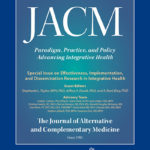Barriers and Facilitators to Integrative Oncology Services in Australia: A Changed Mind Set Required

Objectives: This study aimed to explore barriers and facilitators to integrative oncology (IO) service provision and access in Australia. Design: The study design was mixed method with two substudies: a cross-sectional national cancer service survey of public and private sectors; and focus group interviews and an online survey of cancer survivors. Triangulation analysis of qualitative and quantitative data was used to identify and interrogate meta-themes. Subjects: The cancer service response rate was 93.2% (n = 275/295); 71/275 (25.8%) provided IO. Thirty-three cancer survivors from Anglo-European, Arabic, Vietnamese, and Chinese backgrounds were interviewed, and 121 survivors answered the online survey. Results: IO gaps were substantial, with no services in many regions and cities; a lack of diversity and availability of therapeutic options, including culturally appropriate services; and a mismatch between the high use of natural health products by survivors and types of IO services provided. Two overlapping meta-themes were identified: “barriers and facilitators” and “peoples and institutions”; each with four subthemes, respectively, “access/provision, affordability/funding, information/evidence, and culture/values” and “cancer survivors, healthcare professionals, organizations, and policies.” While affordability/funding was the greatest barrier to survivors and providers, solutions varied (e.g., building a stronger evidence-base, business model advice) and often conflicted (e.g., public verses private sector funding). The most insidious barrier was professional/corporate cultures and values that influenced hospital policies (or lack thereof), conceptions of evidence and the therapeutic alliance. Survivors called for a change of mindset in the culture of medicine and value-based health care. Conclusions: The barriers and facilitators to IO services were more complex than building the evidence-base and demonstrating value to justify funding. To achieve a better alignment of patients’ preferences with service provision, providers require more guidance on clinical governance, business models, local service gaps, and interprofessional collaboration. National strategies and funding models are needed to ensure appropriate, equitable IO service provision.






Lascia un commento
Devi essere connesso per inviare un commento.